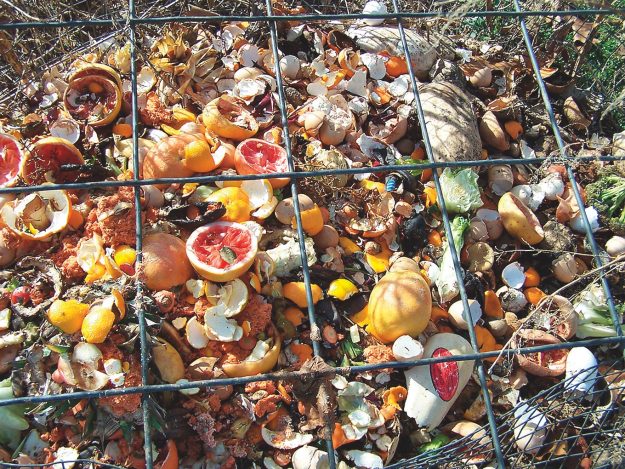It was almost dark when I came upon the bobcat, walking alone on a steep overgrown trail far above the Green Gulch valley. She had been dead for weeks, her black-rimmed lips pulled back in a snarl of protest, tiny soot flies scouring her empty eye sockets. Her belly was slit open and she lay, disemboweled, in her own dry blood. The acrid stench of death rose off her matted fur. I considered carrying the bobcat down to bury her in the farm compost pile but decided against it. She was her own sovereign palace of decay, already well-consumed. I placed her, instead, off the trail, onto a soft mound of chain fern and lady’s bedstraw and hurried down the mountain while I could still see.
This was more than ten years ago, but I still think of that bobcat, especially in this autumn season as we build the last big compost piles of the year, arranging garbage in one giant heap sealed with moldy oat straw drenched in stale green pond water.
Much as I love cross-legged sitting and the Bodhisattva Vows, making compost is my core religious practice. “Life into death into life,” intoned my garden teacher Alan Chadwick as he supervised us in the ancient alchemical art of creating a compost pile, a practice followed by Chinese farmers for more than four thousand years. I take my place in this gardening lineage that reveres and relies on rot and decay as an abiding source of soil fertility.
Compost is an untame culture, turning on the dark side of Nature’s wheel of life where all beings come apart and are recombined. The same clan of microbes and maggots, nematodes and mites, bacteria and fungi that helped to decompose the bobcat on the Zen trail so many years ago are the engine of decomposition in every compost pile. The gardeners’ task is only to create a hospitable site where the culture of compost can unfold.
This work is deeply simple. All you need is a shady piece of ground large enough for a compost pile that is at least 3′ x 3′ x 5′. First you fork open the soil beneath your proposed pile and arrange a base made of old plant stalks, stems, and soft woody debris. Next you mound on top of this base a deep layer of green, nitrogen-rich materials like garden weeds and grass clippings, mixed with animal manure and kitchen scraps. The following layer is dry, carbonaceous material like straw and old leaves, or wood chips and sawdust, all well watered so that your pile is as moist as Avalokiteshvara’s huge heart. Continue to layer your compost green material and then let dry until you have a tall, noble pile, as high as you can reach.

Every compost pile is alive, a teeming sangha of billions of invisible microorganisms digesting your autumn mountain of garbage. In a few short days a healthy compost pile begins to steam with metabolic life as clouds of heat-loving bacteria break down raw protein and complex carbohydrates into amino acids and simple sugars, generating temperatures as high as 160 degrees Fahrenheit. This breakdown stage is followed a few weeks later by a buildup stage that lasts for more than a month as complex fungal networks absorb the pile’s free gases into their web work of mycelia, reducing leaching of nutrients, disarming pollutants and disease pathogens, and physically binding soil and compost together, creating stable aggregates that increase water infiltration and retention.
In the last stage of decomposition a few months later—or sooner, if you turn your pile—your mound will be alive with sweet, woodsy- smelling compost laced with up to one hundred industrious compost insects per square foot, intertwined with writhing red compost worms, testifying by their presence that decomposition is complete.
“All conditioned existence is of the nature to come apart,” observed the Buddha twenty-five hundred years ago. Although this may not be corroborated by the Pali canon, I am confident not only that the Buddha’s teaching was stimulated by upright sitting beneath a sacred pipal tree, but also that in the vicinity of enlightenment there is always a smoking dung heap alive with bobcat bones and rotten melons, arranged to become the deep, black ground of awakening.